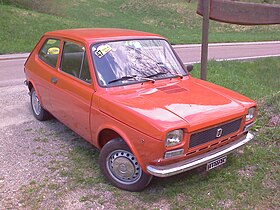Fiat 127
| Fiat 127 | |
|---|---|

A series 1 Fiat 127 2-door
|
|
| Overview | |
| Manufacturer | FIAT |
| Production | 1971–1983 |
| Designer | Pio Manzù |
| Body and chassis | |
| Class | Supermini (B) |
| Body style |
|
| Layout | Transverse front-engine, front-wheel-drive |
| Related | Zastava Koral |
| Chronology | |
| Predecessor | Fiat 850 |
| Successor | Fiat Uno |
| Series 1 | |
|---|---|
 |
|
| Overview | |
| Production | 1971–1977 |
| Powertrain | |
| Engine | 903 cc OHV straight-4 |
| Dimensions | |
| Wheelbase | 2,225 mm (87.6 in) |
| Length | 3,595 mm (141.5 in) |
| Width | 1,525 mm (60.0 in) |
| Height | 1,360 mm (54 in) |
| Series 2 | |
|---|---|
 |
|
| Overview | |
| Production | 1977–1981 |
| Powertrain | |
| Engine | |
| Dimensions | |
| Wheelbase | 2,225 mm (87.6 in) |
| Length | 3,645 mm (143.5 in) |
| Width | 1,527 mm (60.1 in) |
| Height | 1,358 mm (53.5 in) |
| Kerb weight | 688 kg (1,517 lb) |
| Series 3 | |
|---|---|
 |
|
| Overview | |
| Also called | Fiat Stella (Finland) |
| Production | 1982–1983 |
| Powertrain | |
| Engine | 903 cc OHV straight-4 1049 cc OHC straight-4 1301 cc SOHC straight-4 1301 cc straight-4 diesel |
The Fiat 127 is a supermini car produced by Italian car manufacturer FIAT from 1971 to 1983. It was introduced in 1971 as the replacement for the Fiat 850. Production of the 127 in Italy ended in 1983 following the introduction of its replacement, the Fiat Uno.
Initially only available as a two-door saloon when launched in April 1971, a three-door hatchback, using an identical body profile but with a full-depth rear door and folding rear seat, was launched the following year. This was Fiat's first supermini-sized hatchback, along with a state-of-the-art transverse-engine/front-wheel-drive layout, with the transmission mounted on the end of the engine, both design ideas had been fully trialled since 1964, by Fiat's Autobianchi subsidiary with the Autobianchi Primula and 1969 Autobianchi A112 and A111. The 1969 Fiat 128 was the first Fiat badged car to use the same transverse powertrain layout. The 127 used, as the A112, a shrunken version of the 128 platform and the rugged Fiat OHV 100 series 903 cc engine, that had powered the Autobianchi and, with various cylinder capacities, earlier generations of Fiat cars. The 127 also featured a unique transverse leaf spring suspension at the rear. Safety was another area of innovation - the 127 included an articulated steering column and crumple zones for progressive deformation under impact.
The car was one of the first of the modern superminis, and won praise for its utilisation of space (80 percent of the floor space was available for passengers and luggage) as well as its road-holding. It was launched a year before the comparable Renault 5, and before the end of the 1970s most mass market European manufacturers were producing similar cars, notable examples being the Ford Fiesta and Volkswagen Polo, while General Motors added a three-door hatchback to the Opel Kadett range, which was reworked for British production and sold as the Vauxhall Chevette.
...
Wikipedia
